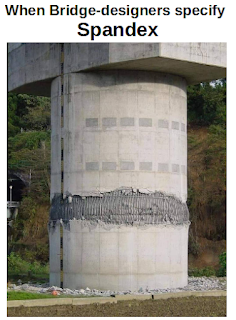I assume this pier or column is hollow and might be filled with rubble. Concrete is expensive.
I looked into how hollow, concrete shapes are made and found this video:
Five-minute run-time
Possible failure modes in the process that might lead to the structural failure as shown in the image are:
- Temporary failure in the vibrator that shakes and compacts the concrete. That might result in a band of unconsolidated concrete which would crumble.
- A short run of dry or inadequately mixed concrete
- An interrupted pour
Are there any concrete guys out there who REALLY know what happened?

Jimmy H and his entourage?
ReplyDeleteThat looks to have been poured in place. Google image search says that is a pic of a bridge support failure after an earthquake in Japan.
ReplyDeleteYeah, those horizontal marks look like joints in the forms, don't they.
DeleteMy Brother in law worked in a prestressed concrete plant that built the spans and support tubes for the Lake Pontchartrain Causeway. He told me the hollow support tubes are formed in centrifuge forms. Bob in B.R.
ReplyDeleteI that column hollow? How do you know?
ReplyDeleteI suspect that it is hollow for a few reasons.
DeleteBased on the bulging of the reinforcing, steel mesh I guesstimate that the column is 1/2" to 1" shorter than it was when-cast. If an 8' diameter column shrank 1", I would have expected more rubble to be piled around the base than is evident.
Then there are the issues of economics. Concrete is very strong in compression (4000psi is a common number) and pure compression, like a pier or support column, is very efficient compared to a beam-in-bending where the center portion is much less stressed than the outer-surfaces.
So my gut-feel...not even an educated guess....is that the column is hollow and maybe has a tamped sand or gravel in-fill.
Trained as a structural engineer after working for 10+ years as a form carpenter, foreman and superintendent, spent 45 + years in construction management, and have done some engineering forensics as well. This looks like a lateral shear failure, likely due to an earthquake. Some of the circular bands in the exterior failure zone appear to be missing, and the top and bottom sections appear to be misaligned somewhat. Reinforced columns fail only after the perimeter reinforcing fails; if this had been hollow you would have seen more crushing of the column.
ReplyDeleteLateral accelerations in strong earthquakes can exceed 2 g, and a large solid concrete column subjected to a short period sharp shock would be expected to exhibit this type of failure.
What usually destroys bridges and buildings is the long period wracking and continued movement created by thick alluvial soil layers under the structure. Think of breaking a wire by flexing it back and forth. Rather like shaking a bowl full of jello, such soils will change the short sharp excitation initially imposed to a long period large amplitude lower G acceleration that twists the structure to failure.
THIS failure, by contrast, appears to be the result of a single intense lateral load that caused a shear failure of the column, which is almost certainly founded on rock or a thin layer of granular soil which transmitted the initial shock with little to no change. QED, such failures often do not destroy the structure; it may be possible to glue this one back together and put it back into service, as was done to several US bridges after Loma Prieta.
Best regards, Historian.
Thank-you, sir.
DeleteMinimum depth of embedment for rebar is 4". Eight times bar diameter for larger sizes which that definitely is. That depth requirement is from both sides.
ReplyDeleteBut since we have a pro here I would go with his answer.